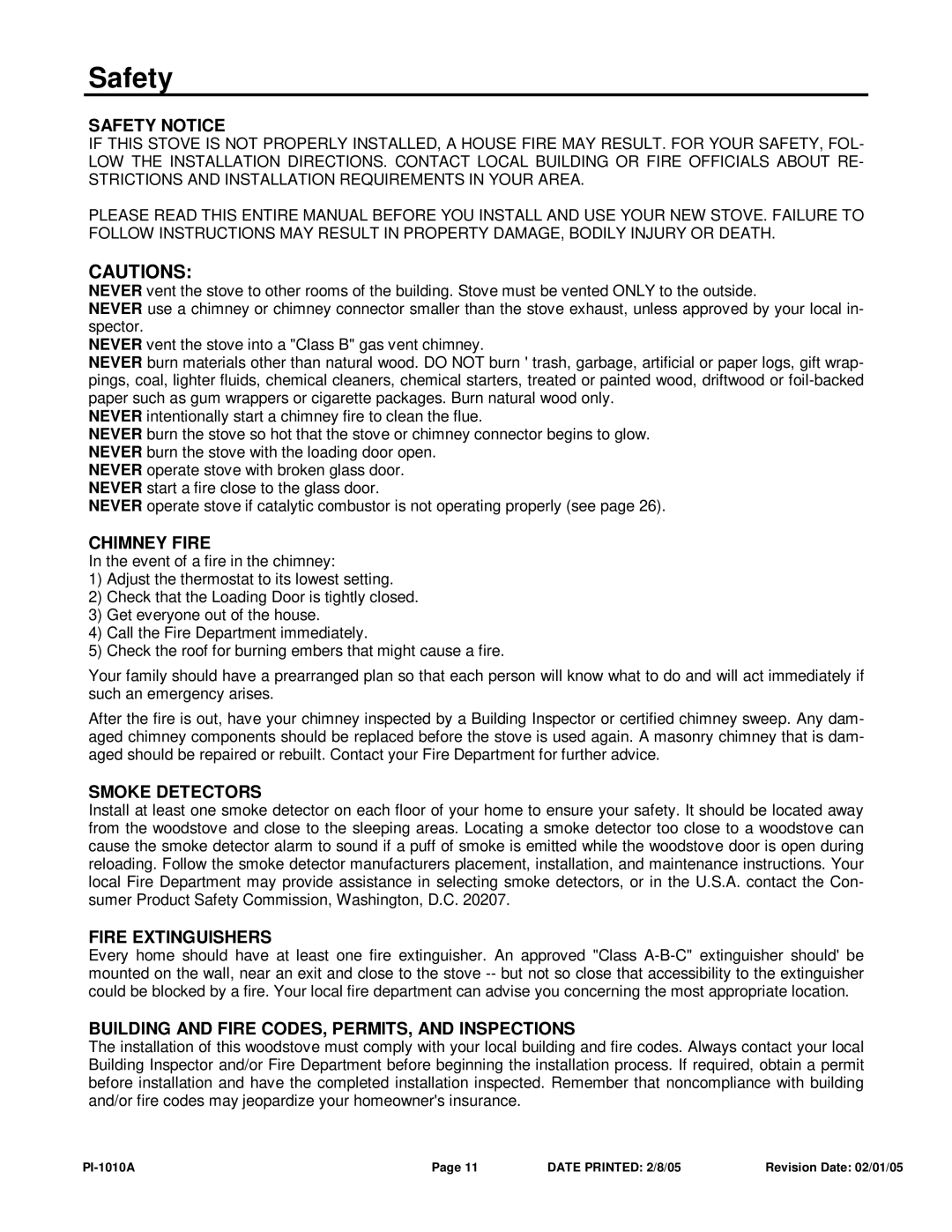Safety
SAFETY NOTICE
IF THIS STOVE IS NOT PROPERLY INSTALLED, A HOUSE FIRE MAY RESULT. FOR YOUR SAFETY, FOL- LOW THE INSTALLATION DIRECTIONS. CONTACT LOCAL BUILDING OR FIRE OFFICIALS ABOUT RE- STRICTIONS AND INSTALLATION REQUIREMENTS IN YOUR AREA.
PLEASE READ THIS ENTIRE MANUAL BEFORE YOU INSTALL AND USE YOUR NEW STOVE. FAILURE TO FOLLOW INSTRUCTIONS MAY RESULT IN PROPERTY DAMAGE, BODILY INJURY OR DEATH.
CAUTIONS:
NEVER vent the stove to other rooms of the building. Stove must be vented ONLY to the outside.
NEVER use a chimney or chimney connector smaller than the stove exhaust, unless approved by your local in- spector.
NEVER vent the stove into a "Class B" gas vent chimney.
NEVER burn materials other than natural wood. DO NOT burn ' trash, garbage, artificial or paper logs, gift wrap- pings, coal, lighter fluids, chemical cleaners, chemical starters, treated or painted wood, driftwood or
NEVER intentionally start a chimney fire to clean the flue.
NEVER burn the stove so hot that the stove or chimney connector begins to glow. NEVER burn the stove with the loading door open.
NEVER operate stove with broken glass door. NEVER start a fire close to the glass door.
NEVER operate stove if catalytic combustor is not operating properly (see page 26).
CHIMNEY FIRE
In the event of a fire in the chimney:
1)Adjust the thermostat to its lowest setting.
2)Check that the Loading Door is tightly closed.
3)Get everyone out of the house.
4)Call the Fire Department immediately.
5)Check the roof for burning embers that might cause a fire.
Your family should have a prearranged plan so that each person will know what to do and will act immediately if such an emergency arises.
After the fire is out, have your chimney inspected by a Building Inspector or certified chimney sweep. Any dam- aged chimney components should be replaced before the stove is used again. A masonry chimney that is dam- aged should be repaired or rebuilt. Contact your Fire Department for further advice.
SMOKE DETECTORS
Install at least one smoke detector on each floor of your home to ensure your safety. It should be located away from the woodstove and close to the sleeping areas. Locating a smoke detector too close to a woodstove can cause the smoke detector alarm to sound if a puff of smoke is emitted while the woodstove door is open during reloading. Follow the smoke detector manufacturers placement, installation, and maintenance instructions. Your local Fire Department may provide assistance in selecting smoke detectors, or in the U.S.A. contact the Con- sumer Product Safety Commission, Washington, D.C. 20207.
FIRE EXTINGUISHERS
Every home should have at least one fire extinguisher. An approved "Class
BUILDING AND FIRE CODES, PERMITS, AND INSPECTIONS
The installation of this woodstove must comply with your local building and fire codes. Always contact your local Building Inspector and/or Fire Department before beginning the installation process. If required, obtain a permit before installation and have the completed installation inspected. Remember that noncompliance with building and/or fire codes may jeopardize your homeowner's insurance.
Page 11 | DATE PRINTED: 2/8/05 | Revision Date: 02/01/05 |
